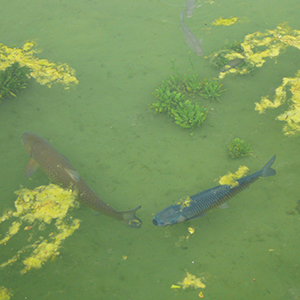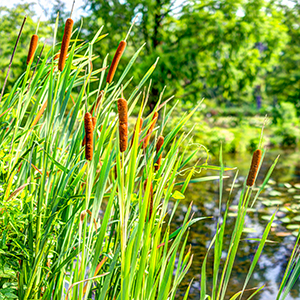There is an old axiom that states “Mother Nature abhors a lake or pond and wants to fill it in”. While we could be talking centuries or millennia for this to happen, the tools she uses to accomplish this are what plagues us now. Vegetation encroaching along the perimeter, Cattails growing in-masse as they inch their way into the pond, submersed vegetation growing on the bottom collecting sediment, and floating plants growing so thick as to block sunlight from interacting with the water; these are some examples of how Mother Nature takes back her own. Since our tenure is limited to decades, we strive to improve the landscape to fit within our sense of a satisfying presence. It is hard work to maintain an attractive appearance, especially dealing with such a liquid environment. There is no “silver bullet” we can use to correct the issues that confront us. The best approach applies the finest Integrated Pest Management (IPM) practices using the staples of the Lake and Pond Management industry; (1) Aeration, (2) Select Chemical Application and (3) Biologicals (i.e., Fish).
No two issues are the same, so therefore the approach may differ on how best to bring your ecological landscape into respectable conformity. We have the knowledge and the experience to determine the best path to solving your lake and pond issues.
Algae:
Usually when you see large green mats floating on the surface of your pond, the first instinct is to think you have an algae bloom. In many cases you would be right. Algae is very prolific, and it does not take much to generate the ugly green bloom. One method to employ is Aeration. See the information under Aerations and Fountains. While there are over a thousand different types of algae, the list of Algicides is small: usually copper-based in composition. Techniques to deal with this problem have not changed much over the years. There are some new products that are not copper based and do work well, but as always, one must know the limitations and scope of the project before attempting to address the issue.Algal blooms are created when three primary things come together: (1) Food supply, (2) Sunlight and (3) Temperature. The food supply is a combination of organic debris such as grass clippings and leaves off a tree. They accumulate on the bottom and start a compost heap that helps to feed the algae. Sunlight helps to drive that part of the “equation” that gets the bloom going and rising Temperature’s help accelerate the bloom to grow.
Floating Plants:
There are some floating plants that can be confused with an Algal Bloom. These plants (e.g.., Water Meal and Duck Weed) are tiny in size but they reproduce at an aggressive rate that can literally cover the surface of a pond in short order. Other floating plants are much larger in size (e.g., Water Hyacinth and Lilies). In short, they all pose a threat to the water body if left unchecked.
Submersed Plants:
Typically, one would not notice these unless swimming or boating and the vegetation (e.g., Hydrilla, Milfoil or Pondweed) becomes a barrier by wrapping itself up in the swimmer or around the boat propeller. Such a dense vegetative population growing on the bottom creates a degradation of the long-term health of the lake or pond. Care must be exercised when trying to deal with this situation.
Shoreline / Emergent Plants:
Cattails would represent the classic plant for this category. A more dominate and highly invasive plant in this category, over Cattails, is Phragmites. This plant is much more aggressive than the Cattail and can overwhelm even the native population of beneficial plants. Phragmites is arch-typical of the reason to initiate long-term management controls.


